Monthly Topics 2019
- December 2019
Young Women in the Workforce - November 2019
Midcareer Tips - October 2019
Families and Paternity Leave - September 2019
Health Care Access Factors - August 2019
Human Trafficking - July 2019
Taking Public Transit as a Woman - June 2020
Personal Security - May 2019
Being an Ally in the Workplace - April 2019
Interviewing - March 2019
Hiring and Measuring Progress - February 2019
Spotlight on Women in ITE
December 2019: Young Women in the Workforce
Starting your career is a big hurdle. Regardless of education or experience, being a young woman in the workforce presents its own special challenges. This blog post discusses strategies, tips, things to watch out for, and words of encouragement.
Before Accepting a Job Offer
The application process can be nerve-wracking for anyone. But for young women entering the workforce it can feel quite daunting “going up against” panels of primarily old white men. You may feel like there’s no way you’re qualified or confident enough. There are a few things you can do to make yourself feel more prepared.
- Don’t be afraid to negotiate.
You only get one chance to get the salary/benefits package you want. Know your industry and how much your salary should be based on your experience level and education. Even if your starting offer is the amount you want, maybe you love to travel and want another few days or an additional week of vacation. Carnevale [1] provides some great advice on how to handle the salary expectation questions during an interview.
- You don’t need to be 100% qualified to apply for a job.
Often, employers get overzealous with their wish lists for new employees. They never actually expect to find someone that can check off every box. So if you find a posting that you’re really interested in, go for it! One study showed that though women apply to fewer jobs than men, women are more likely to get hired for the jobs they do apply for [2]. The Harvard Business Review also had an article discussing why women don’t apply for jobs unless they feel 100% qualified. In contrast, on average men apply to jobs when they feel only 60% qualified!
- You’re not alone in freaking out about interviews.
Talk to your peers and mentors about how they handled interview anxiety. One tip is to go to job fairs, conferences, and workshops and talk to employers you’re not necessarily interested in working for but treat the conversations as practice interviews. Get used to talking about your experiences, asking about companies, and generally being, if not relaxed, visibly calm and collected. Lowman [4] has five tips for looking confident in an interview. Don’t be afraid to take advantage of interview workshops!
- Ask to talk to women already working at the company.
If you’re nervous to ask about female employees specifically, ask if you can talk to other young/new employees in general. This is one of the best ways to help you get a feel for the company’s environment, especially if you can talk to them without a supervisor present. If you aren’t introduced to any women and you don’t see any around, it may be a sign to keep in mind but don’t take it as a deal-breaker.
After Accepting a Job Offer
You got your first (or second, or third) job! Congrats! Now you have a new hurdle: staying afloat in a new and sometimes overwhelming environment. There are plenty of articles about how to succeed in your career, but one in particular by Rene Banglesdorf gives nine pieces of advice to young women specifically [5]. Listed below are six with some insight from my own experiences:
- “Be eager to learn but don’t be a pushover.”
As a young, female faculty member, I’ve been warned that I will be asked to sit on numerous university committees and that I should NOT accept all or even any of them prior to getting tenure. While encouraging diversity on committees, panels, etc. is important, don’t let yourself become the token female and don’t let it impact your ability to do your job.
- “Find other women to connect with.”
I’ve found a number of women in my department to ask about their experiences in their career, particularly in assessing department attitudes towards pregnancy and how to handle minor instances of sexism. I often feel more comfortable talking to them first, before my male supervisor.
- “Stay away from comparisons.”
One thing I am still actively working on is learning to not compare myself to others. Your career will never be the same as anyone else’s. While having some examples to use as guides or gauges can be helpful, I’ve found that directly comparing myself often leads to unnecessary stress and anxiety.
- “Play your own game.”
Similar to the last point, your career will be different from your peers’. Figure out what you want and pick and choose the opportunities that help you move towards that goal. For example, for many of my colleagues, applying for NSF grants is the gold standard. However, that does not align with my research and career goals so I shouldn’t expend as much, if any, effort in those applications.
- “Learn to accept criticism.”
One tip I have often been told is to wait a few days before reading reviewer comments or critiques, especially if it comes with a rejection. Let yourself accept the existence of the critique first before diving into what can potentially be difficult comments. One thing I still struggle with is not taking critique personally, particularly from anonymous reviewers.
- “Don’t stop learning.”
This may seem obvious but keep attending conferences, workshops, and seminars when possible. Not only will it help you keep up to date with the newest advancements, but it is also a great way to network! The best part is, as a young woman, your company will likely be incentivized to cover your travel to these events.
Lastly, don’t let yourself doubt how or why you got your position. If you feel like you haven’t accomplished much, list out all of the things you’ve done, from minor daily tasks to major awards. Sometimes, it helps to see everything listed on paper to remind yourself just how much you’ve done. And again, don’t compare your list to anyone else’s!
Encouraging Young Women
For young women to join and remain in the transportation workforce, it is important for others to encourage them. In this case, “others” can and should include other young women, older women, men, etc. in the profession. Below are some words of wisdom from some accomplished female members of ITE.
“Don’t try to do everything! I often overextend myself and feel that I sometimes do not give my best effort. I am still trying to learn to say no – and have found that I can more easily say, Not Now! Gives me time to reassess and prioritize.” – Marsha Anderson Bomar
“Don’t feel like you must overachieve or go it alone. There are plenty of mentors, official or unofficial, who are so willing to help guide young people. The tendency is to overlook the wisdom of the elders, but now that I am one, I can see what lies ahead. I also would encourage a more balanced life. Work-life balance is way too hard to do it without a support system. Most of all… ENJOY THE JOURNEY!!” – Jenny Grote
“I was often the quiet one at the table listening to all the different viewpoints and following my instincts to only raise my voice when necessary. I sometimes felt my voice wasn’t being heard or that I wasn’t contributing enough. I realized with time that in most instances, my role was to simply listen to all viewpoints and then form the direction to take. So I would say to my younger self - be confident in yourself, it is a long journey.” – Paula Flores
“Follow your instincts. Don’t let someone else talk you into staying in a situation that isn’t working.” – Alyssa Rodriguez
Finally, we need to change the stereotype of transportation engineers and engineers in general. Studies and anecdotes alike have shown that young women are more likely to choose and remain in engineering fields when they see role models that look like themselves. #ILookLikeAnEngineer [6] is a few years old but still relevant today. We encourage you to post a photo of yourself in your job, perhaps with #ILookLikeITE!
References
[1] R. Carnevale, "How to Answer Salary Expectations During an Interview," The Ladders, 12 November 2019. [Online]. Available: https://www.theladders.com/career-advice/how-to-answer-salary-expectations-during-an-interview.
[2] M. Ignatova, "New Report: Women Apply to Fewer Jobs than Men, But are More Likely to Get Hired," LinkedIn, 5 March 2019. [Online]. Available: https://business.linkedin.com/talent-solutions/blog/diversity/2019/how-women-find-jobs-gender-report.
[3] T. S. Mohr, "Why Women Don't Apply for Jobs Unless They're 100% Qualified," Harvard Business Review, 25 August 2014. [Online]. Available: https://hbr.org/2014/08/why-women-dont-apply-for-jobs-unless-theyre-100-qualified.
[4] E. Lowman, "5 Ways to Look Confident in an Interview (Even When You're Freaking Out)," The Muse, [Online]. Available: https://www.themuse.com/advice/5-ways-to-look-confident-in-an-interview-even-when-youre-freaking-out.
[5] R. Banglesdorf, "9 Tips for Young Women Entering the Workforce," Vault, 17 May 2019. [Online]. Available: https://www.vault.com/blogs/admit-one-vaults-mba-law-school-and-college-blog/9-tips-for-young-women-entering-the-workforce.
[6] USA TODAY, "Female engineers fight stereotype with help of hashtag," 8 August 2015. [Online]. Available: https://www.youtube.com/watch?v=rG8gN3Fg9gE.
November 2019: MidCareer Tips
What does taking care of your career mean?
Taking care of your career may mean a number of things. For some women in STEM it may simply mean staying in the industry, but it may also mean balancing family, finding meaningful work and certainly might mean earning deserved opportunities.
Tips/Advice
Here is a collection of general tips for midcareer women from “10 Best Career Moves for Women in their 30’s”[1]. The list might give you ideas on where to focus your research or how to coach a colleague:
- Create an Action Plan
- Negotiate Your Pay
- Position Yourself for Advancement
- Brand Yourself
- Create Opportunities by Networking
- Find a Mentor
- Figure Out What Makes you Happy
- Advance Your Education
- Take More Risks
- Stop Being Your Own Worst Critic
Looking into more detail, much of the mid-career related research points towards finding help with your career; like Sally Blount from the Kellogg School of Management at Northwestern University who stated that “Research shows that this is the time [Mid-career] when effective mentorship and sponsorship are critical, and a lack of good guidance increases the likelihood of a career exit for women.”[2]
Similarly, an interview by Joan Michelson, Rainia Washington, Vice President, Global Diversity and Inclusion at Lockheed Martin, stated there are three areas women should be focusing on in their mid-career: 1) Figuring out what “making a difference” means to you 2) “Do your values and the values in which you grew up really align with the company in which you work” 3) “3 C’s of leadership, which compose of Communication – Learn to communicate effectively (speaking and writing); Character – Follow through on what you say you’ll do, “operating with integrity and with honesty in everything”; and Courage – “Getting the information in order to challenge the status quo, for me,” Washington said, “has been extremely important.”[3]
A publication of Mineta Transportation Institute, “Attracting and Retaining Women in the Transportation Industry” by Jodi Godfrey and Robert L. Bertini, shared similar findings such as mentoring, professional organization involvement, opportunities, and flexible work schedules to be crucial for women to remain in the transportation industry.[4]
While it may not seem intuitive that women would leave STEM in their mid-careers, research shows they do in high numbers. According to the Society of Women Engineers (SWE) only 30 percent of the female students who graduate from engineering still work in the field 20 years later.
There are different reasons as to why women leave the engineering profession during their mid-careers. In the research titled, “Women’s Reasons for Leaving the Engineering Field” by Nadya A. Fouad, Wen-Hsin Chang, Min Wan and Romila Singh. The authors found four (4) main reasons women left the engineering profession “work-family imbalance (16%), loss of interest in engineering work (12%), lack of opportunities for advancement (11%), and dislike of engineering tasks (9%).”[5]
In addition, according to a research by the National Science Foundation (NSF) in 2015, it shows that a greater percentage of women, not working in the STEM profession to tend to their families, as compare to man, shown in Table 1, below.[6]
Table 1: Reasons for not working among scientists and engineers in 2015
|
Race, ethnicity, and sex |
Family |
Job not available |
Layoff |
Retired |
|
White women |
26.4 |
9.8 |
3.3 |
52.1 |
|
White men |
5.8 |
9.2 |
7.3 |
75.0 |
|
Asian women |
38.7 |
12.4 |
2.3 |
17.7 |
|
Asian men |
3.9 |
18.0 |
13.6 |
39.5 |
|
URM women |
24.3 |
18.6 |
7.8 |
36.1 |
|
URM men |
11.5 |
22.6 |
11.1 |
55.2 |
URM=Underrepresented minority
Women continue in the engineering field are facing greater demands at work and at home concurrently in during their mid-career.
Resources
More suggestions for resources related to helping women who are mid-career are here:
Within ITE
- Mentorship – The Matson and Hammond mentoring program. A online resource for ITE members, rather you want to be a mentee or mentor.
- Position Yourself for Advancement/Create Opportunities by Networking/Advance Your Education - LeadershipITE is valuable resource for all those and more.
- Advance Your Education – ITE Annual Meeting and Exhibiton, monthly ITE Journal, ITE Community and webinars.
- ITE Podcast - The Value of Professional Development with Marsha Anderson Bomar
Outside of ITE
TED Talks
[2] https://insight.kellogg.northwestern.edu/article/getting-more-women-into-the-c-suite-means-keeping-them-in-the-talent-pipeline
[3] https://www.forbes.com/sites/joanmichelson2/2018/08/10/the-3cs-of-leadership-innovating-with-purpose/#1d4896093095
October 2019: Family and Paternity Leave
I can't believe my son just turned 15. It doesn't seem that long ago that my husband and I were bringing our little baby boy home from the hospital. There was so much to enjoy, but also major decisions to be made. Who would watch our son after his arrival? What would we do when we both needed to return to work? These aren’t things you can just decide once your bundle of joy arrives. My husband and I both worked full-time. He was a science teacher and I was a civil engineer. My employer provided maternity leave, but the only way my husband could take time off was to use the few days he was allocated for vacation and sick time (which isn’t much for teachers). Many things have changed since 2004, but not much progress has been made in the US with respect to parental leave, especially for fathers.
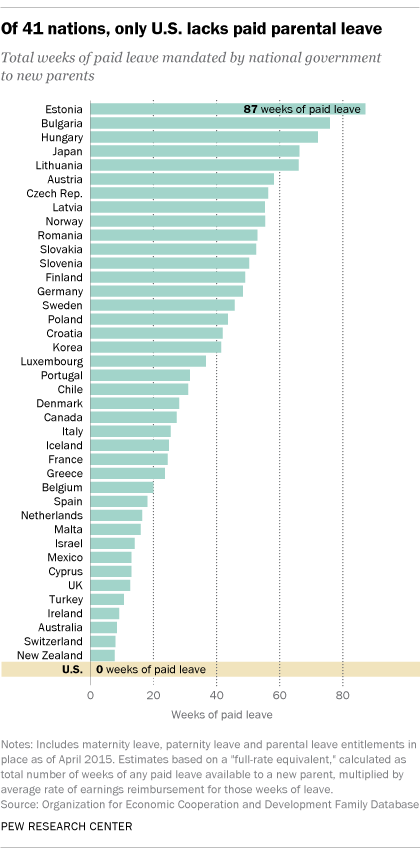 So what is parental or family leave? In short, it is an employee benefit that includes maternity, paternity, and adoption leave. A 2016 Pew Research Study found that the US is the only country among those surveyed that does not mandate any paid leave for new parents. The US does have several laws in place for paid parental leave, including the 1993 Family and Medical Leave Act (FMLA). However, I didn’t realize under FMLA only about 60% of American workers are entitled to leave. Some states have taken action and passed laws to address parental leave, such as New York State, California, New Jersey, and New Hampshire. In addition, an increasing number of companies offer paid parental leave to parents.
So what is parental or family leave? In short, it is an employee benefit that includes maternity, paternity, and adoption leave. A 2016 Pew Research Study found that the US is the only country among those surveyed that does not mandate any paid leave for new parents. The US does have several laws in place for paid parental leave, including the 1993 Family and Medical Leave Act (FMLA). However, I didn’t realize under FMLA only about 60% of American workers are entitled to leave. Some states have taken action and passed laws to address parental leave, such as New York State, California, New Jersey, and New Hampshire. In addition, an increasing number of companies offer paid parental leave to parents.
But what about dad specifically? Paternity leave refers to a period of absence from work granted to a father after or shortly before the birth of his child. In 2017, a Pew Research survey showed that about seven-in-ten Americans (69%) supported paid paternity leave. Yet, a 2016 National Partnership for Women & Families report found that only 41 percent of America’s workforce have employers that provide paid paternity leave to some workers. Only 9 percent work for employers that provide paid paternity leave for all workers. A lot of times, paternity leave is used as a perk for certain employees. Still, some corporations are looking to offer more progressive leave options. For example, Netflix has allowed fathers to take unlimited leave during the first year of the child’s life after a child is born or adopted. However, as noted by Adam Bulger, "Companies offering progressive paternity leave are the exception, not the rule."
 Let’s face it. Times have changed. The roles of moms and dads have converged. Yet, according to a fact sheet provided by the National Partnership for Women and Families three out of four fathers (75%) in professional jobs took one week or less off from work after their most recent child was born. In addition, nearly 60% of low-income fathers took no paid time off. Besides paternal leave availability, what stops fathers from taking leave after a child is born or adopted? The primary reason why fathers limit their time off is because it is important to them to be a financial provider. Other concerns include harassment, discrimination, mistreatment, and negative impact on career. In other countries, including the more than 80 who do provide paternity leave, there is still a stigma to men actually accessing this benefit. Interesting partners are joining the scene, including dove soap who is surveying our Canadian friends to understand the barriers and inform what can be done.
Let’s face it. Times have changed. The roles of moms and dads have converged. Yet, according to a fact sheet provided by the National Partnership for Women and Families three out of four fathers (75%) in professional jobs took one week or less off from work after their most recent child was born. In addition, nearly 60% of low-income fathers took no paid time off. Besides paternal leave availability, what stops fathers from taking leave after a child is born or adopted? The primary reason why fathers limit their time off is because it is important to them to be a financial provider. Other concerns include harassment, discrimination, mistreatment, and negative impact on career. In other countries, including the more than 80 who do provide paternity leave, there is still a stigma to men actually accessing this benefit. Interesting partners are joining the scene, including dove soap who is surveying our Canadian friends to understand the barriers and inform what can be done.
So why am I even discussing paternity leave? A recent study from the University of Illinois and Seoul University found several benefits for fathers, mothers, and the family when fathers take even just a few days of paid leave. More specifically, the fathers who took paid leave were found to have higher life and job satisfaction, which in turn led to increasing the mother’s satisfaction with their family relationship. Karen Kramer, Assistant Professor, University of Illinois says “If we want to support families and their labor force outcomes, maybe a better way is to support the father ...By giving the father even just a few days of leave, there’s an effect on the couple for the long-term. That’s the important thing.” The study also acknowledges the challenge of getting fathers to take paid paternity leave (even when it is offered) as oftentimes, fathers fear being penalized in some way. "We need to encourage fathers to take the leave and help them understand the positive effects for the children, the couple, and the labor force." says Karen Kramer.
At the end of the day, I guess what I want you to take away is that when a child is born or adopted, support for mothers and fathers is equally important. I have learned over the years, that work will always be there (in some form or another). But my family will not. Children grow up way too fast! So what can you do? Looks for ways to make changes at your work that support the family. Support your co-workers and their decisions. Come alongside them. After all, we are a community. A community of transportation professionals that I have always felt like is my extended family.
September 2019: Health Care Access Factors
Transportation affects public health in many ways, one of which is in providing access. People use the transportation system to get to appointments with doctors or specialists or travel to the hospital in an emergency. Women interface with this system in particular with their role as careers within the family – taking children to and from appointments, for instance – as well as with particular health needs such as maternity and childbirth. A 2017 study also found that women are more likely than men to delay preventative care or make other tradeoffs due to cost. Delayed care in emergencies or skipping preventative care leads to negative health outcomes, often among populations that are already underserved.
What is healthcare access?
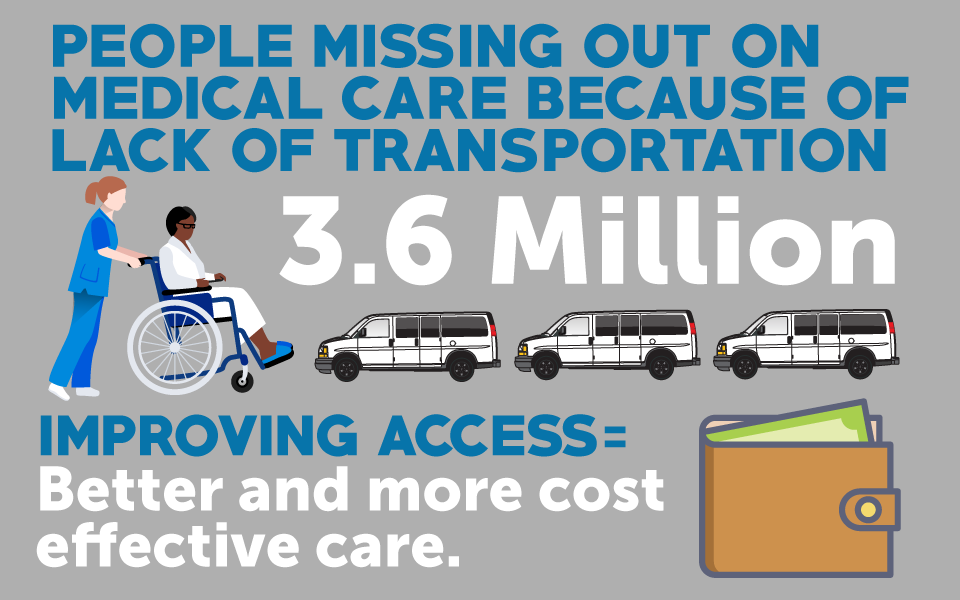
Transportation Pathway to Better
Health Outcomes, Community
Catalyst Blog
There are many aspects to the ability to access health care. Penchansky and Thomas divided this into five categories:
- Availability – is there an adequate supply of healthcare facilities
- Accessibility – can potential clients physically access the facility, given transportation availability, travel time, and cost
- Accommodation – is the facility organized in a manner that clients can accept and utilize, e.g., appointment systems, hours of service, scheduling services
- Affordability – can clients afford to utilize the services, including insurance and co-pays
- Acceptability – are clients comfortable and satisfied with receiving services at the facility
The physical access part is the most relevant for transportation engineers, though availability also enters the picture from a planning perspective. The final three factors can explain why the nearest facility is not always the best option (or a possible option) for a patient.
What is the problem?
Low-income and rural residents often have a difficult time accessing care, due to either distance or cost of travel. This impacts health in both lacking proper preventative care and on survivability in emergency scenarios. A TCRP report found that in a given year, 3.6 million people in the United States are both deemed transportation-disadvantaged, and miss non-emergency health care because they don’t have a way to get there. This is a conservative estimate, and the population in this group is expected to grow.
Most of the research on women accessing care focuses on pre- and post-natal care and childbirth. Adequate prenatal care is strongly linked to a decline in infant mortality rates, and transportation has been shown to be a factor in accessing this care. In Haiti, a study found that poor road conditions significantly reduce the likelihood of a woman receiving prenatal care, and living far from a hospital made it less likely that the birth would be attended by trained medical personnel. A study in the Netherlands found that longer travel times to the hospital correlated with higher mortality risk.
In the United States, rural hospitals have been closing, further complicating access for residents. A study in Alabama (https://www.jabfm.org/content/31/4/542) compared access to a local OB practice in rural counties and found that local services resulted in improvement in the infant mortality rate. Rural counties often only have one or two providers, and travel to the next county over can be prohibitive, especially when one is relying on a ride from other people.
What can we do about it?
Providing Non-Emergency Medical Transportation (NEMT) for low-income road users has been shown to be cost-effective in improving access to care. These results held for a variety of conditions, both preventative and chronic, in terms of decreasing cost of medical care and/or improving length and quality of life. Planning for the first and last mile may also improve access through regular transit service as well.
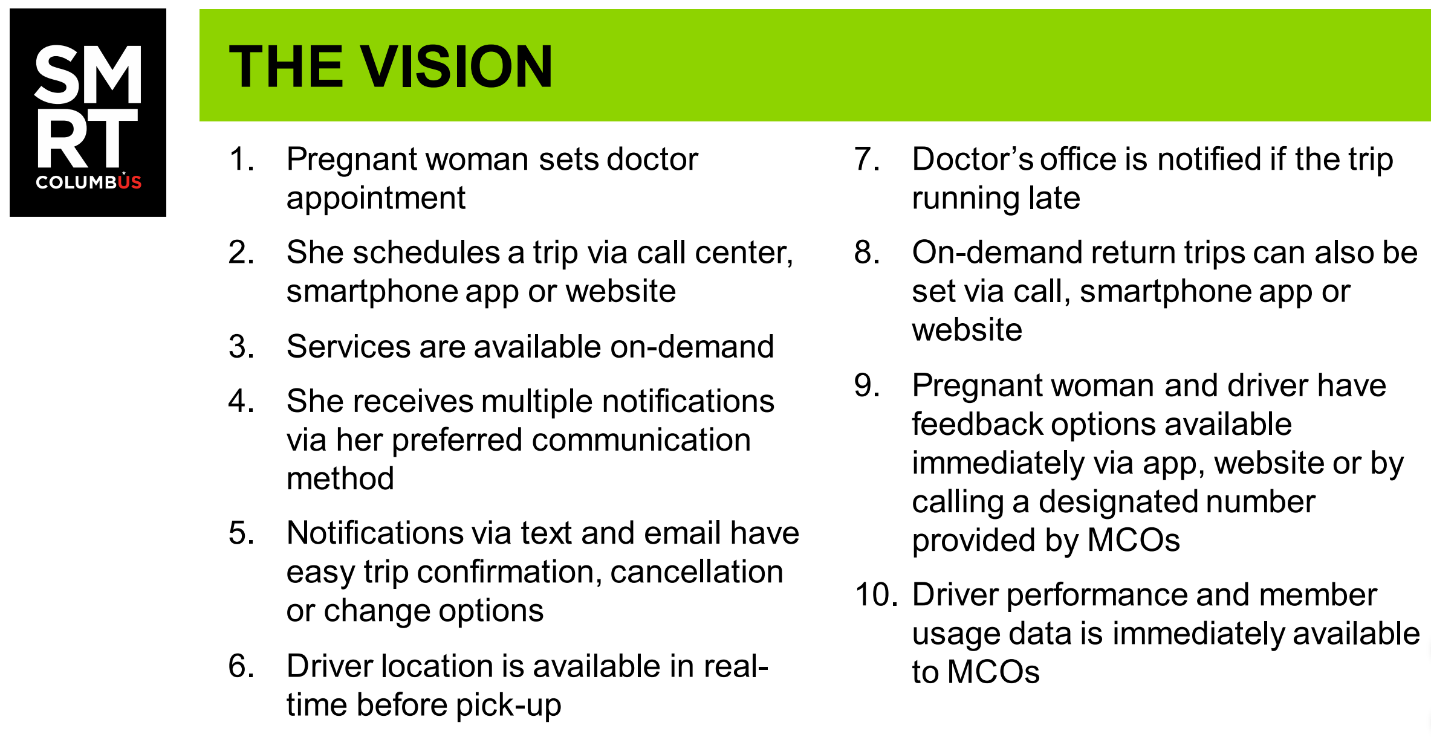
The City of Columbus is running a Prenatal Trip Assistance pilot program as part of its Smart City Challenge award to improve outcomes in specific zip codes with high infant mortality rates. Their goal is to “understand how best to provide travel assistance to expectant women so lack of reliable transportation is no longer a barrier to receiving early and adequate prenatal care.” Part of the system is an app called Rides4Baby, inspired by Uber and Lyft, that allows women to easily schedule rides, receive reminders, and view the driver’s approach in real time.
Gaps in the current systems were identified in focus groups, including communication, rides not arriving on time, and lack of car seats for other kids. Women reported getting frustrated and not going to the doctor as a result. The program aims to streamline the process and provide women with information throughout, as well as communicate delays to the doctor’s office. The pilot is slated to go through the end of December, and ITE is hosting a free webinar on the project test plan on October 2nd .
Land use and planning can aid in increasing both the availability and accessibility of health care services. It’s an analogous problem to food deserts – places where residents cannot access fresh and healthy food options within a given radius – and often overlap with the same population. Health care access may benefit from the same solutions. In some cases, that can mean bringing care to the community instead, such as a mobile food market or a hearing clinic in a van.
Lack of transportation is only one barrier to health care access, but it is still an important one, and every barrier removed leads to a healthier populace. These issues also extend to other access problems, such as jobs, healthy food, and other amenities. It’s important for transportation professionals to look at the ways that people are using the system, and the gaps where people cannot make the trips they need to. New technologies and ways of providing transportation offer opportunities to expand access through the transportation system to vital goods and services.
References:
[1] Penchansky, R., and J. W. Thomas. The Concept of Access: Definition and Relationship to Consumer Satisfaction. Medical Care, Vol. 19, No. 2, 1981, pp. 127-140.
[2] Gage, A. J., and M. Guirlene Calixte. Effects of the physical accessibility of maternal health services on their use in rural Haiti. Popul Stud (Camb), Vol. 60, No. 3, 2006, pp. 271-288.
[3] Powell, J., C. Skinner, D. Lavender, D. Avery, and J. Leeper. Obstetric Care by Family Physicians and Infant Mortality in Rural Alabama. J Am Board Fam Med, Vol. 31, No. 4, 2018, pp. 542-549.
[4] Ravelli, A. C., K. J. Jager, M. H. de Groot, J. J. Erwich, G. C. Rijninks-van Driel, M. Tromp, M. Eskes, A. Abu-Hanna, and B. W. Mol. Travel time from home to hospital and adverse perinatal outcomes in women at term in the Netherlands. BJOG, Vol. 118, No. 4, 2011, pp. 457-465.
August 2019: Human Trafficking Awareness as Transportation Professionals
Human trafficking is defined as the recruitment, harboring, transportation, provision, obtaining, patronizing, or soliciting of a person for labor or services through force, fraud, or coercion for the purpose of involuntary servitude, peonage, debt bondage, commercial sex acts, or slavery. As of 2016, a study out of the United Nations’ International Labour Organization estimated that there are 4 million victims of sex trafficking globally. Many people may naively think that this is happening somewhere else, and not near them, but they are wrong. This is not a third world problem. This problem is happening right under our noses, in our own neighborhoods, every day.
Why Should We Care?
 Human trafficking awareness is important to me, as a transportation professional, because I am aware that I have an opportunity to make a difference. I have the ability to save a victims life by simply being aware of what I see around me and reporting suspicious activity when I see it.
Human trafficking awareness is important to me, as a transportation professional, because I am aware that I have an opportunity to make a difference. I have the ability to save a victims life by simply being aware of what I see around me and reporting suspicious activity when I see it.
Human trafficking typically depends on transportation systems to operate – moving their victims “hidden in plain sight.” While human traffickers look for all opportunities to recruit, bus terminals, train stations, and airports are key places for victim identification and public awareness. Human traffickers are counting on people not paying attention and not knowing the signs to look for or the questions to ask. There are a number of red flags, or indicators, which can help alert you to identify victims. If sharing this information helps just one person get rescued from human trafficking, then it has served a worthwhile purpose.
The Federal Transit Administration produced and released an educational video that is just over seven minutes long that is intended to raise awareness about human trafficking and point out the signs of potential human trafficking that may be present on public transportation systems.
How Can We Be Part of the Solution?
 Elizabeth Connell, Steven Jones, Ph.D., and Javonda Williams, Ph.D. co authored an ITE Journal Article on “Human Trafficking and the Transportation Profession” where transportation professionals are called to action to educate ourselves, and our colleagues, through training and outreach efforts, advanced technology applications and innovative data analytics. As transportation professionals, we can use the opportunities that our profession affords us to identify and reduce human trafficking in our communities.
Elizabeth Connell, Steven Jones, Ph.D., and Javonda Williams, Ph.D. co authored an ITE Journal Article on “Human Trafficking and the Transportation Profession” where transportation professionals are called to action to educate ourselves, and our colleagues, through training and outreach efforts, advanced technology applications and innovative data analytics. As transportation professionals, we can use the opportunities that our profession affords us to identify and reduce human trafficking in our communities.
Transportation Leaders Against Human Trafficking is a U.S. DOT initiative that is comprised of transportation stakeholders working together to combat human trafficking by focusing on industry leadership, industry training and education, policy development, public awareness, and information sharing and analysis.
“TLAHT offers a variety of resources, including a transportation leaders pledge, counter-trafficking strategies, training resources, and public awareness materials. Contact us to become a partner and join other transportation stakeholders across the U.S. through this collaborative effort.”
Sector-Specific Messaging Key to Fighting Human Trafficking
 “Mode-specific training should be niche-specific, while public awareness campaigns should have a universal message. Specific messaging for a specific sector is key,” Kendis Paris, executive director of Truckers Against Trafficking said. “What a school bus driver’s going to see is very different from what a truck driver’s going to see.”
“Mode-specific training should be niche-specific, while public awareness campaigns should have a universal message. Specific messaging for a specific sector is key,” Kendis Paris, executive director of Truckers Against Trafficking said. “What a school bus driver’s going to see is very different from what a truck driver’s going to see.”
Traffickers take advantage of a large influx of people, like those attending a Super Bowl, to solicit illegal services. Gregory Nevano, assistant director of U.S. Immigration and Customs Enforcement’s Homeland Security Investigations, said that his team found 1,560 potential clients through undercover ads targeting people who responded to traffickers’ solicitations during the 2018 Super Bowl in Minneapolis.”
“Slavery in the 21st Century” is an article that highlights the successes of tailored training in the airline industry. The Blue Light Initiative is one component of the Department of Homeland Security’s campaign to train aviation personal to identify potential traffickers and human trafficking victims, and to report their suspicions to federal law enforcement.
Some telltale signs of a human trafficking victim include a passenger who is:
- not in control of his or her travel documents.
- edgy or frightened.
- bruised on his or her body.
- being controlled by a fellow passenger.
- unsure of his or her final destination.
To report suspected human trafficking in the United States, call 1-866-347-2423. To get help from the National Human Trafficking Hotline, dial 1-888-373-7888 or text HELP or INFO to BeFree (233733).
The Michigan State Police released a YouTube video to raise awareness on human trafficking as well, which is truly eye-opening to reveal how much you miss, even when you think you are paying attention.
By focusing education efforts on awareness and reporting options, we may be able to save a life. APTA also has some links to various successful initiatives
Examples of Global Public Awareness Campaigns on Human Trafficking
 Blue Blindfold Campaign in Ireland.
Blue Blindfold Campaign in Ireland.
Look Beneath the Surface in the United States.
Blue Heart Campaign (La campagne Cœur Bleu) launched by the UN’s Office on Drugs and Crime (UNDOC).
Open Your Eyes to Human Trafficking produced by the UNGIFT.
Here, You Have Rights (Ici, vous avez des droits) poster in Canada by the RCMP.
The Stop the Traffik Campaign is a global movement of individuals, communities, and organizations that work to prevent human trafficking worldwide through a wide variety of initiatives and awareness-raising projects.
The TruckSTOP Campaign (La campagne TruckSTOP) provides frequent travelers and truck drivers with the knowledge they need to identify suspected cases of human trafficking while informing local law enforcement.
The Girls in Red Light District video highlights the reality of false promises made to women of a dance career in Western Europe as part of the Stop the Traffik global campaign.
The Government of Canada’s Don’t Become a Victim of the Illegal Trade in Canada brochure campaign offers citizens and immigrants tips and resources to avoid becoming a victim of human trafficking in Canada.
Insightful Interview with Polly Hanson

and Emergency Management,
APTA
We asked Polly Hanson, Director of Security and Emergency Management at the American Public Transportation Association (APTA) some questions about why we should learn about human trafficking awareness, and what we can do about it as transportation professionals.
Ms. Hanson has an impressive background in transportation security having served as the Assistant General Manager of WMATA, the Executive Director of the Metropolitan Police Department of the District of Columbia, The Director of Law Enforcement and Security at the U.S. Department of the Interior, and the Chief of Police at Amtrak prior to her current role at APTA.
Q1. Why should transportation professionals want to learn about human trafficking?
Many cities use special events like the Super Bowl to focus on Human Trafficking and because transit is used to get to those kinds of special events transportation agencies participate is public awareness campaigns. Human Trafficking is an everyday occurrence and traffickers use all modes of transportation to move and meet victims. Transit’s large passenger numbers, anonymity and low costs make it attractive to traffickers.
Q2. What can we do, as transportation professionals, to combat this critical issue in society?
Providing awareness training to employees, especially these in the field, driving buses, operating trains, collecting fares and cleaning facilities is an important way to combat this critical issue. While I was the Chief of the Amtrak Police, we trained all 20,000 Amtrak employees and used January, Human Trafficking Awareness Month to refresh that awareness training. Those efforts did result in aid being provided to victims of human trafficking and the identification of human traffickers.
Q3. What resources can you share with us that may help us become more aware of the warning signs of human trafficking?
At Amtrak we participated in the Blue Campaign but an agency can partner with DOT or local law enforcement to provide awareness training to employees.
July 2019: Taking Public Transit as a Woman
Gender Differences in Travel Behavior
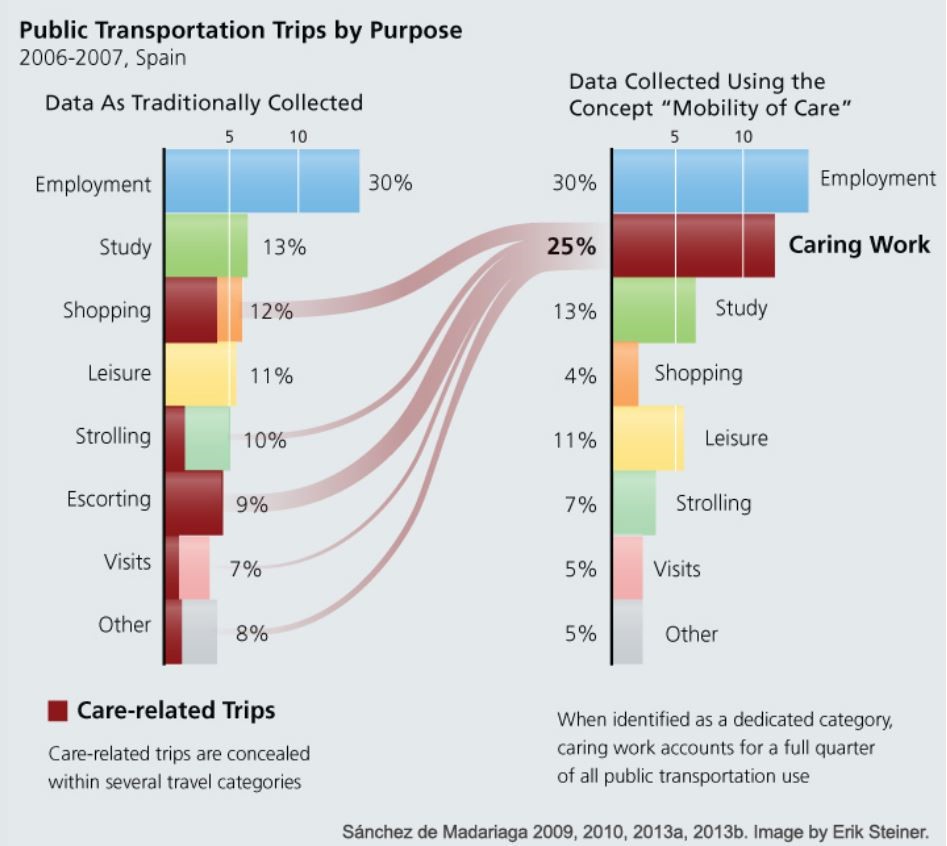
Image by Erik Steiner
The study Public Transportation: Rethinking Concepts and Theories carried out by Gendered Innovations demonstrates that unpaid caring work and typical trip chaining behaviors associated with this work are often not accommodated adequately by transit agencies, due to the methods commonly used to gather and analyze statistics related to public transportation. Transit agencies often categorize trips based on purpose, and include items such as employment, shopping, family/personal errands, school, social and recreational, etc in travel surveys.
Trips that fall under the category of caring work are often concealed within several of the categories, and therefore transit services are typically designed to cater towards commuters travelling to and from employment since this category appears to account for the most significant percentage of trips. Caring work is defined as “unpaid labor performed by adults for children or other dependents, including labor related to the upkeep of a household”. As shown in the graphic, when caring work is included as a separate trip category in the travel survey it accounts for a large percentage of public transportation trips, therefore, it is important for transit agencies to provide adequate service to accommodate these types of trips.
Additionally, statistics demonstrate that in the United States and several countries within the European Union women spend significantly more time on caring work compared to men. In 2010, the average woman in the United States spent twice as much time caring for and helping children in her household compared to the average man in the United States. This highlights that fact that consideration of caring work is key to ensuring public transportation is designed to work well for the whole population. One of the first steps that can be taken to plan transit services that account for gender differences in public transportation use and trip patterns, is to rethink the trip categories included on travel surveys and disaggregate the survey data by gender. This will more clearly illustrate the use of public transportation for caring work and provide a starting point for creating facilities and schedules that better accommodate this type of work.
The paper titled Examining Trip-Chaining Behavior: A Comparison of Travel by Men and Women written by Nancy McGuckin and Elaine Murakami examines trip chaining behavior of adult men and women traveling on weekdays based on 1995 data from the Nationwide Personal Transportation Survey (NPTS – versions later than 1995 now known as the National Household Travel Survey (NHTS)). The data included in the NPTS is largely based on private vehicle trips, but the patterns that emerge from these trips can be used to understand how public transportation services could be designed to provide for these types of travel demand. This study identifies that while an increasing percentage of women are participating in the workforce, women are still more likely than men to engage in trip chaining behaviors, and these trips are likely to occur in peak travel periods on the way between work and home.
Findings from the NPTS data demonstrate that adult women make a greater number of trips overall compared to men and create complex work-trip chains that include multiple stop destinations between work and home, which men are less likely to partake in. Both men and women are less likely to trip chain on the way to work compared to on the way home from work, but women are still more likely than men to make one or more stops on the way to work. Particularly in households with children, women are more likely to make stops on the way to work or home from work compared to women or men in households without children. The findings of this study indicate that gender differences in travel are likely to continue to prevail even as women resemble a greater percentage of the workforce. Therefore, accommodating different travel behaviors within the population will continue to be an important consideration when planning for public transportation.
Research has demonstrated that there are often distinct differences in travel behaviors and trip purposes between women and men. Studies show that women spend significantly more time on caring work (household errands, transporting children, visiting elderly relatives, etc.) than men, and caring work can often be dependent on public transportation. This leads to travel behavior called trip-chaining, where one or more stops are made between an origin and destination. Trip-chaining can present significantly different needs for transit services compared to commuter-based transit services that cater to work/home trips for employment.
In addition to the differences in travel behaviors and trip purposes between women and men, taking public transportation as a woman can be a very different experience compared to taking public transportation as a man. As we explored in June, women often place a greater value on personal security compared to men, have a greater fear of being harassed while traveling, and will be more likely to change their travel behavior due to fear. Public transportation has also proven to be a common location where harassment occurs. This month, the focus will be on women’s safety specifically in transit environments. Discussion below includes some of the safety issues prevalent within many transit systems and examples of strategies to improve safety on public transportation such as design of transit facilities, and awareness campaigns undertaken by various transit agencies to educate the public and empower victims of harassment or bystanders to speak up if an incident occurs.
Women’s Safety in Transit Environments
Harassment on Public Transit
Dorothy Schulz and Susan Gilbert wrote a paper titled “Women and Transit Security: A New Look at an Old Issue”, which dates concerns related to women’s safety and security in transit environments back to 1904, when New York City’s first subway opened. The extreme overcrowding of the subway in the first few years of its service resulted in many women enduring harassment and unwanted sexual contact.
In a more recent context, an article from the Washington Post, “Why the #MeToo Movement is a Public Transportation Issue”, discusses how the theme of sexual harassment and assault experiences which took place on transit have emerged as part of the “#MeToo” campaign. Professor of urban planning at the University of California, Los Angeles, Anastasia Loukaitou-Sideris explains that transit environments such as buses, trains and stations provide opportunities for perpetrators due to the nature of these transit environments which involves public spaces that can be either extremely crowded with many strangers or very empty. Incidents on public transit can greatly impact ridership, and individuals who experience harassment on transit may alter their travel behavior to avoid certain lines or stations, or even permanently stop using public transit altogether.
A survey completed by Cornell University and Hollaback! found that public transit and public transit stations were the third and fourth most common locations for harassment to occur. They also determined that 77% of the survey respondents chose to take different modes of transportation based on their experiences with harassment.
There are several other articles available which explore the issue of harassment on public transportation experienced by women and help to demonstrate the magnitude of the problem.
Designing Safe Public Transit Facilities
There are many great resources which can be used by transportation professionals to design for safe public transit from a gendered perspective, and work towards the goal of eliminating harassment of women on public transportation.
The paper Hot Spots for Bus Crime: The Importance of Environmental Attributes written by Anastasia Loukaitou-Sideris examines environmental factors of bus stops with high concentration of crimes relative to bus stops in similar locations with much lower crime rates. A literature review on the concepts of crime prevention through environmental design (CPTED) is included in the study, which identifies the impact that the environmental design can have on the occurrence of crime and illustrates strategies to mitigate crime using principles such as defensible space. After identifying the ten most crime-ridden bus stops in Los Angeles and comparing these to four low-crime bus stops within the same area, the study concludes that most of the high-crime bus stops share several similar environmental attributes. Some of these attributes include: being located in commercial areas at intersections of multilane streets, not visible by surrounding stores, lack of adequate lighting, surrounded by empty lots or semi vacant buildings with many escape routes nearby such as alleys, located adjacent to liquor stores or bars, and surrounded by signs of physical and social incivilities such as litter, graffiti, or broken windows. Careful placement and design of bus stops using the principles of CPTED can help to prevent opportunity for crimes such as harassment and assault.
UN Women, the United Nations entity dedicated to gender equality and empowerment of women, has provided a module on their virtual knowledge center called Safe Cities. This provides guidance for creating safe cities and communities for women and girls to live in which they can be free of violence, based on knowledge of experts and case studies of programs that have been successful. One of the elements included in Safe Cities is Safe Public Transit for Women and Girls , which outlines the importance of safe public transportation systems for women and girls’ ability to exercise their rights to freedom of movement and enjoyment of their city and its pubic spaces. Mobility is often necessary for people to participate in daily life, and safe public transit allows women and girls to exercise their mobility without fear. Some of the strategies recommended to create safe public transportation include: request stop programs that allow women to get off closer to their destinations between stops at night, using principles of CPTED when designing transit stops and stations, passenger assistance alarms on transit vehicles and emergency access telephones on platforms, surveillance technologies in transit stations and transit vehicles, and providing uniformed patrol presence in transit environments. Ensuring participation of female and male transport users of all ages in project design, implementation, monitoring and evaluation is also essential in planning safe transportation from a gender perspective.
Public Education and Awareness
Many transit agencies are taking action to increase public awareness about sexual harassment within transit environments and increase reporting of such events.
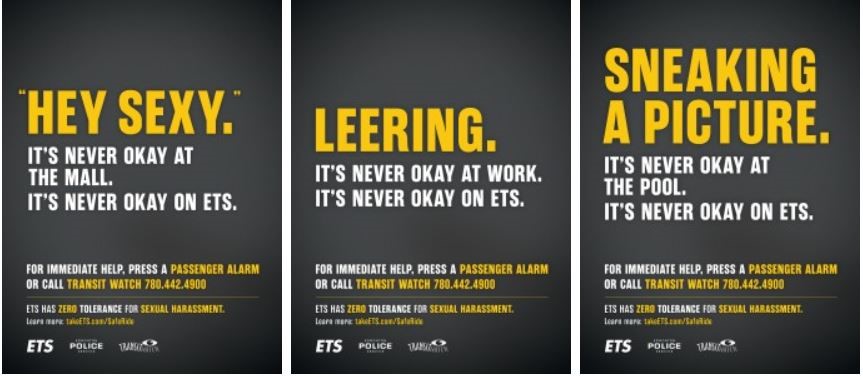
Edmonton Transit System (ETS) has implemented several safety awareness campaigns to ensure that transit riders feel safe and can seek assistance if needed for emergencies, as well as report inappropriate behavior. One of the first campaigns implemented by ETS as part of a public education program was “It’s Never Okay”. This program seeks to empower individuals to be comfortable in calling for help if they are a victim of harassment or a witness to an event. The messages implemented during this campaign advertise that sexual harassment is not acceptable and will not be tolerated by ETS.
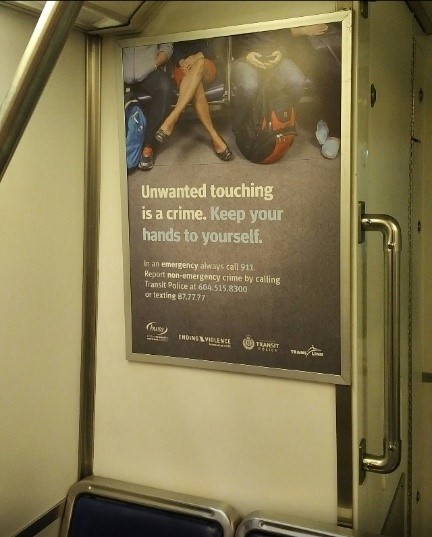
In 2016, the Metro Vancouver Transit Police, partnered with women’s organizations Battered Women’s Support Services (BWSS) and Ending Violence Association, launched a poster campaign to raise awareness about sexual harassment and assault on public transit. As discussed in the media release on the BWSS website, this program was implemented after reports of sexual harassment and assault on transit to police increased by 28% in 2015. Angela Marie MacDougall, Executive Director at BWSS, summarized the importance of raising public awareness around harassment on transit:
“Sexual harassment and assault public awareness campaigns are necessary actions against silence and ignorance. Helping to create an environment where those that would perpetrate could no longer be guaranteed they could assault women and girls with impunity.”
Calgary Transit has implemented a Transit Watch Program which allows riders to report concerns. One of the newest
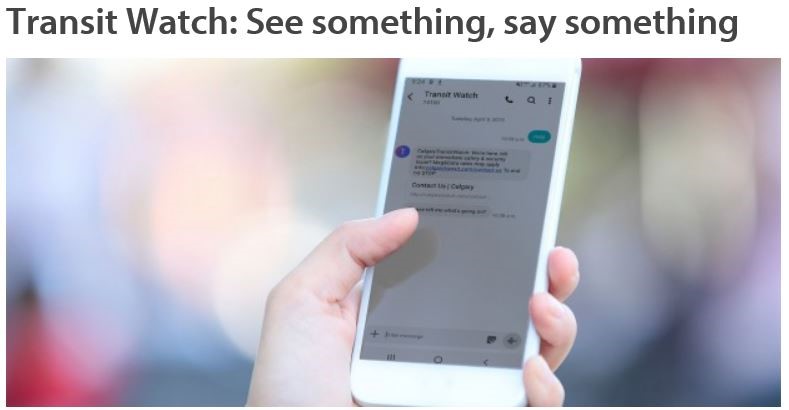
features of this program is a text messaging option for reporting safety concerns. This allows transit users to discreetly report safety or security concerns, providing another option in addition to help buttons and phones that are provided at transit stations.
This short video clip promoted by the Victoria State Government in Australia demonstrates how witnesses to harassment can also play an important role in reinforcing the message that it this is not acceptable behavior.
June 2019: The Gender Dimension to Personal Security in Transportation

Everyone has the desire to travel safely. Road safety, as it relates to crashes, is a core consideration in the design of road infrastructure. Personal security can also be considered a component of road safety, as similar to crashes, street harassment and assault can cause injury, affect mobility, and have other lasting impacts. There is a gender dimension to personal security in transportation, as research has shown that women place a greater value on personal security than men, report greater fear of being assaulted or harassed while traveling, and demonstrate more extreme changes in travel behaviour in response to this fear.
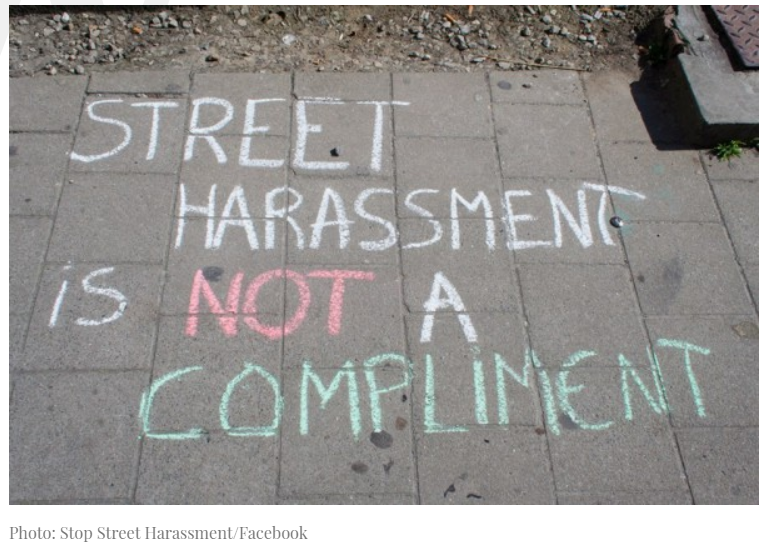
Loukaitou-Sideris wrote How to Ease Women’s Fear of Transportation Environments: Case Studies and Best Practices and summarized the mobility impacts of personal security issues in transportation for women:
“Whether traveling by bus, automobile, or other modes, women’s fear of transportation facilities – such as parking structures, buses, train cars, and bus stops – in turn affects the way women engage in travel, and may preclude them from a basic right to the city: the ability to move carefree from origin to destination without worrying that a ‘wrong choice’ of mode, transit setting, or time of travel would have consequences for their safety.”
In response to the fear of being assaulted or harassed, individuals may limit their activities and adopt precautionary measures and strategies which affect their mobility patterns: they may not travel at night, avoid certain places and certain modes of transportation, take specific routes, or only use certain modes of transportation at certain times of the day or if traveling accompanied.
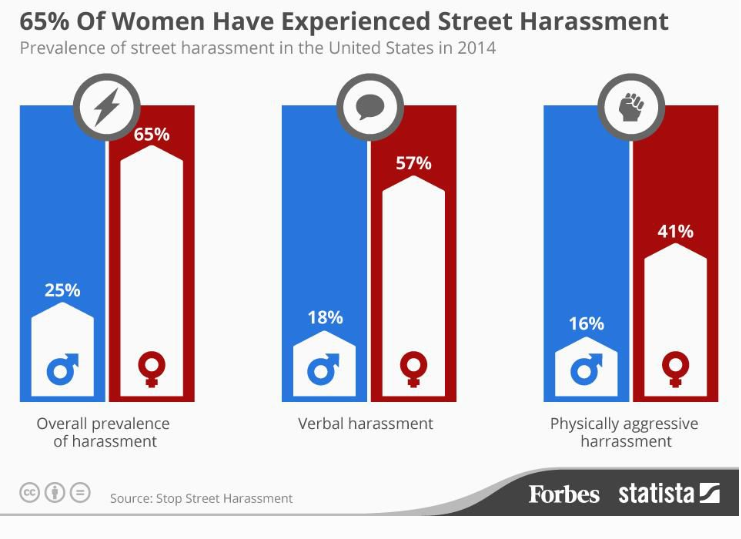
Incidents of street harassment often go unreported. In a survey in New York City, U.S., 63 percent of respondents indicated being sexually harassed while traveling on the subway, while 96 percent of those respondents failed to report the incidents to police. Similarly, a survey conducted in Ottawa, Canada found that 97 percent of respondents had experienced street harassment within the past year and 90 percent had never reported the incident.
Underreporting of these incidents limits our ability to understand the true magnitude of the problem. However, organizations like Harassmap and Hollaback! are shedding light on the prevalence of these issues. These organizations allow people to openly and anonymously report incidents of street harassment, which are then displayed on an online map that is publicly available. Harassmap was launched in Egypt and has received thousands of reports of street harassment. Hollaback! began in 2005 and is now active internationally in chapters across North America, Latin America, Europe, Asia, and elsewhere. The ability to visualize the location of incidents on a map can be a helpful tool for transportation practitioners, particularly those interested in applying concepts of Crime Prevention Through Environmental Design (CPTED).
Crime Prevention Through Environmental Design (CPTED)
The concept of CPTED is that the built environment can be manipulated to alter human behaviour and reduce crime and fear of crime. CPTED is a component of overarching crime prevention strategies and deals exclusively with the physical environment (other crime prevention components deal with policing, enforcement, and social programs to address root causes of crime).

Erik Witsoe/EyeEm/Getty Images
Aspects of the built environment that contribute to feelings of insecurity and fear of crime include darkness, desolation, lack of maintenance (i.e. graffiti and litter), and poor environmental quality.
The main components of CPTED are natural surveillance, natural access control, and territorial reinforcement. Having natural surveillance means that people using the space can see others and be seen by others. The idea behind natural surveillance is that offenders may be less likely to commit crime if they can be seen by the public, and people using the space would be less afraid of crime if they are not isolated and can access others for help. Natural access control is about clearly defining boundaries that guide and influence a person’s movement. Territorial reinforcement aims to assign a sense of ownership and purpose to space, so that users are comfortable and aware of their environment. Providing clear sightlines, alternative exits, escape opportunities, and reducing potential hiding spaces are important CPTED practices.
 Incorporating CPTED principles into street design creates a safer feeling environment for everyone, regardless of gender.
Incorporating CPTED principles into street design creates a safer feeling environment for everyone, regardless of gender.
CPTED Resources and Women’s Safety Audits
The International CPTED Association has several online resources and information on how to obtain a professional CPTED certification.
The purpose of a safety audit is to identify aspects of the built and social environment that may contribute to crime or fear of crime, develop solutions, and develop an implementation plan for those solutions. A global survey of 163 local government-community partnerships on women’s safety found that women’s safety audits are the most commonly used tool. METRAC is a Canadian not-for-profit organization responsible for developing the first Women’s Safety Audit in 1989. They now offer security audits for neighbourhoods, campuses, and workplaces.
Learning from Women to Create Gender Inclusive Cities contains several findings and case studies of women’s safety audits from around the world.
May 2019: Being an Ally in the Workplace
When discussing how to advance women in the workplace, much of the emphasis is placed on what women can do to advance their own careers. This month looks at ways that others can be allies for women throughout their careers. Several strategies laid out in the resources focus on how men can be an ally for women in the workplace, but many can be used by other women.
The goal of the ally is not to provide special treatment to certain employees but to be aware of how people may be treated differently in the workplace and learn techniques to treat everyone fairly. While some strategies, like mentoring, require a significant time commitment, others are as simple as recognizing someone in a meeting for a good idea. The strategies do not focus on fixing negative behavior by calling it out, but instead focus on promoting good ideas and how to recognize when detrimental things are said or done in the workplace.
The Merriam Webster dictionary defines an ally as one that is associated with another as a helper : a person or group that provides assistance and support in an ongoing effort, activity, or struggle. (https://www.merriam-webster.com/dictionary/ally)
How to Become Allies for Women in the Workplace
The three following articles provide information for how to become allies for women in the workplace. Strategies work for both men and women, and some can apply to any minority groups in the workplace. One significant takeaway from these three articles and others on the subject is to start by listening. Listening may be the most important aspect of any initiative so the ally can understand the issues at hand before trying to resolve any of them.
The following Harvard Business Review article provides initial steps for men to be an ally for women in the workplace. The recommendations start with respectfully listening and learning the issues before taking a more active role in gender social justice: https://hbr.org/2018/10/how-men-can-become-better-allies-to-women
This Forbes article provides five ways that men can be allies for women in the workplace by recognizing and correcting innapropriate behavior or by mentoring women: https://www.forbes.com/sites/emiliearies/2017/08/15/5-ways-men-can-be-womens-allies-at-work/#3dd0b3fb13de
The third article highlights the importance of women advancing and mentoring other women in the workplace. Progress to equality in the workforce is slow and requires approaching the issue from all angles: https://hbr.org/2018/09/dont-underestimate-the-power-of-women-supporting-each-other-at-work?utm_source=linkedin&utm_medium=social&utm_campaign=hbr
Advice from the Experts
Deborah Tannen "Talking from 9 to 5" (http://www.deborahtannen.com/talking-from-9-to-5)
Deborah Tannen's book "Talking from 9 to 5", and the movie based on the book, are almost 25 years old, but still resonate today. A professor showed the movie to all transportation graduate students to show examples of how men and women typically speak, and how that impacts how their ideas are received by others. It helped me understand how I could subtly change the way I was speaking to communicate more effectively in addition to understanding how communication typically differs between men and women.
Bentley University's Center for Women in Business (https://wit.abcd.harvard.edu/files/wit/files/cwb_men_as_allies_research_report_spring_2017.pdf)
The Center for Women in Business completed a report in 2017 outlining the current research related to being an ally for women in the workplace. The report explains how creating allies in the workplace is part of a larger diversity and inclusion initiative and lays out steps to create an allies initiative. The citations provide a list of sources to find additional information on the topic.
April 2019: Interviewing
Interviewing is stressful and can be intimidating. You are meeting and talking with a person or panel that may decide your future based on a short amount of time in front of them. Some people are great at first impressions and putting that best foot forward. Others struggle and while they may be the right or best candidate, they can't convey that in an intense interview.
Further, the position may sound like your dream job, a milestone position or even a foot in the door but how do you as the possible employee know that it is the right/best decision? How do you know that you aren't stepping in to a toxic environment (outside of the work description)? How do you ask the questions that give you that insight without turning the interviewer off?
I believe that we have all struggled with these issues as we consider a new position and as we interview for it. What is the right demeanor? What is the right energy to give off? Is this all even more crucial as women? If these questions don't resonate with you or remind you of situations you have been in, great, but if they do, let's start a conversation about interviewing.
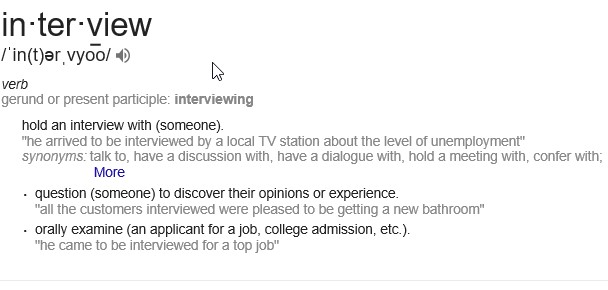
Insightful Interviewing Tips from Shelley Row
 It is essential to know your brand and have a brand statement. Your brand statement succinctly states your skills and the value system you bring to work (dependable, professional, responsible, creative). Here is an example of a brand statement:
It is essential to know your brand and have a brand statement. Your brand statement succinctly states your skills and the value system you bring to work (dependable, professional, responsible, creative). Here is an example of a brand statement:
I am a successful executive who loves a challenge. I provide:
Big picture clarity,
Well-organized action and
Polished presentation
I bring professionalism, integrity, politeness and self-awareness to my work.
- Instead of ending with pleasantries, end the interview with a short strong summary of your attributes and statement about why you are THE choice for the job.
- Use mental priming prior to the interview. Priming is a method to put your mind and body into a positive, strong mindset. For example, think of a time you felt confident or think of a project where you felt good about your contribution. Bring these into your mind just prior to the interview. Research shows that priming has an impact on the confidence you project in the interview.
- Know your values so that you can determine if the organization and work environment provide alignment. If you value family time, don’t look at organizations with a go-go attitude and expectations of long hours.
Three Articles
This article speaks to how some companies are trying to get more out of an interview. Don't be thrown off by these tactics, be prepared for different lines of questioning and different atmospheres or situations meant to gauge your responses. https://www.theblaze.com/news/2016/02/22/charles-schwab-ceo-reveals-how-he-tests-job-candidates-by-taking-them-to-breakfast-having-restaurant-mess-up-their-order/amp
This article is also on the subject of interviewers using different and stressful situations to gauge a potential employee. We are all a little nervous, excited, etc. when we go in to an interview, but be true to yourself and follow some of the tips from Shelley to help get you through. https://www.linkedin.com/feed/news/when-a-job-interview-goes-very-wrong-4960042/
This article challenges employers and potential employees to continue to grow and flex within a position. Know what employers are looking for and what skills you can develop or enhance when entering a new position. Never stop learning and bettering yourself as a professional. https://gusto.com/framework/hr/jeff-bezos-hiring-tips/
March 2019: Hiring and Measuring Progress
According to a 2014 US News & World Report, 24% of the overall engineering workforce are women with racial minorities occupying only 12% of the workforce. A 2017 report by the Environmental Financial Consulting Group, Inc. (EFCG) showed that 26% of the overall engineering workforce are women with racial minorities occupying only 11% of the workforce. These numbers suggest that more can be done to promote diversity in the engineering field. Diversity hiring is hiring based on merit with special care taken to ensure procedures are free from biases related to a candidate’s age, race, gender, religion, sexual orientation, and other personal characteristics that are unrelated to their job performance. This month we take a look at why diversity in the engineering field is important, as well as challenges of hiring diverse employees, methods of attracting a diverse pool of applicants, retaining diverse talent and measuring progress.
Diversity is Key
.png) An article by Sharon L. Walker, Interim Dean, Bourns College of Engineering Professor of Chemical and Environmental Engineering , “WHY DIVERSITY IS KEY TO THE FUTURE OF ENGINEERING” outline four key reasons: innovation and talent, profit, shifting demographics and fair treatment. A key takeaway from this article is that with a diverse engineering field we can capitalize on a range of perspectives that will broaden our innovation and contribute to equality in our field. You can access this article at https://engineeringonline.ucr.edu/blog/why-diversity-is-key-to-the-future-of-engineering/.
An article by Sharon L. Walker, Interim Dean, Bourns College of Engineering Professor of Chemical and Environmental Engineering , “WHY DIVERSITY IS KEY TO THE FUTURE OF ENGINEERING” outline four key reasons: innovation and talent, profit, shifting demographics and fair treatment. A key takeaway from this article is that with a diverse engineering field we can capitalize on a range of perspectives that will broaden our innovation and contribute to equality in our field. You can access this article at https://engineeringonline.ucr.edu/blog/why-diversity-is-key-to-the-future-of-engineering/.
Hiring Challenges
The challenge of hiring diverse employees lies directly within the hiring process itself. How does a company advertise for positions? Simply placing ads on websites and/or using recruiters is not enough. An article in Forbes by Marny Smith, “Help Wanted: Hiring with Diversity & Inclusion in Mind” provides eight tips on making diversity and inclusion a key part of your hiring strategy. Some of the tips include hiring for “culture add” not “culture fit” and being thoughtful in your interview process. These tips can help a company move the diversity initiative to the next stage. This article can be found at https://www.forbes.com/sites/gradsoflife/2019/02/12/help-wanted-hiring-with-diversity--inclusion-in-mind/#38ec40c956c8.
Attracting A Diverse Pool

Retention
Retaining that diverse pool of talent can also be a challenge. "Diversity gets people into the room, but inclusion keeps them there." When employees feel that they are part of a team regardless of their diversity, everyone prospers. The success of similar diverse employees can reinforce the potential for success of another diverse employee. Mentorships have been shown to retain talent, not only at a particular company but also in the field of engineering overall. A publication by Women In ITE committee member Jodi Godfrey, MSCE and co-author Robert L. Bertini, PH.D, both with the Center for Urban Transportation Research at the University of South Florida (USF) titled “Attracting and Retaining Women in the Transportation Industry”, detail major findings and recommendations on attracting and retaining women. The paper can be found at http://transweb.sjsu.edu/sites/default/files/1893-Godfrey-Attract-Retain-Women-Transportation.pdf.
Measuring Progress
Finally, measuring progress means more than just diversity hire percentages. Progress should be measured based upon several key indicators. What is the company’s diversity applicant to hire ratio? Are the diverse employees engaged in professional memberships? It there a diverse pool of attendees enrolled in learning development courses? Does the company have a mentoring program that is diverse in both mentor and mentee? What is the diversity ratio of company promotions? How do these percentages compare to national and/or industry statistics? Once a baseline is established and goals are set, measuring the success of a goal is critical to achieving a more diverse workforce in the engineering field. An article by Bärí A. Williams, head of business operations at StubHub North America, outlines “8 Ways To Measure Diversity That Have Nothing To Do With Hiring”. The article describes how companies must be intentional about creating a culture of diversity to be successful in their diversity initiatives. The article can be read at http://fortune.com/2017/04/20/workplace-diversity/.
Ultimately, companies should develop a process for changing the diversity pool in the workplace. The process should include the company’s intention or goal of what the company wants to accomplish, using the goals to make a commitment and then taking actions that reflect the intention and help achieve the commitment.
Follow the @ITEHQ on Twitter and Women In ITE community forum for additional posts all month. #WomenofITE
February 2019: Spotlight on Women in ITE
To start our crusade, thought we might spotlight some of the talent right here in ITE. We asked several women leaders at all stages of their careers a series of questions about things that have impacted their lives and careers. Their responses give us insight in four areas: mentors/role models, their best advice, and around coaching girls on Engineering and ITE.
Another reason to spotlight the many women who have shaped the face of transportation and ITE is to celebrate that today in 2019 we have two women candidates for ITE International Vice President, the first time in the history of the organization!
Today’s Women in ITE Sub-committee was formed in 2018 and builds off of a tradition from 1994 when Marsha Anderson Bomar, ITE’s first female president, realized there were very few women at ITE’s Annual Meetings. She invited them all to what would become the first Women’s Power Lunch. Today’s sub-committee has a mission to share emerging research and projects that are tackling gender in design and in the workplace, but the group also aims to coach young professionals through finding the best advice - so please enjoy and remember to get involved for Introduce a Girl to Engineering day!
Mentors and Role Models
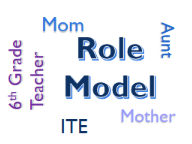
When asked about role models the responses ranged from mom/mother to teachers/professors and various ITE members that have influenced their lives.
My mom also helped the other kids on our block with their homework, college applications, scholarship applications, and moral support. Seeing this willingness to give has inspired me to follow her example and be a woman of action. Strong women need to be role models to help others realize their potential.
-Lynn LaMunyon, ITE 2019 International Vice President Candidate
Professionally, it’s my aunt. She was one of the first women to complete a chemical engineering degree at my alma mater. As someone to look up to, she reminds me that you can establish your career on your own terms and make time for adventures outside of work. She’s a great example of work-life balance.
-Alyssa Rodriguez, ITE 2019 International Vice President Candidate
I was promoted to Deputy Director over the Street Maintenance Division of 300 blue-collar laborers. I had never supervised that many people at one time, and they had never had a woman boss before. I ended up making lemonade out of lemons, mostly because I set up a voluntary Mentor Program to show them I cared about their careers and helped them promote up the ladder, if they chose to.
-Jenny Grote, ITE 2002 President
Advice
When asked what advice you would give to your younger self, the answers focused on being confident in who you are and don’t feel like you have to do everything yourself.
Don’t try to do everything! I often overextend myself and feel that I sometimes do not give my best effort. I am still trying to learn to say no – and have found that I can more easily say, Not Now! Gives me time to reassess and prioritize.
-Marsha Anderson Bomar, ITE 1994 President
Don’t feel like you must overachieve or go it alone. There are plenty of mentors, official or unofficial, who are so willing to help guide young people. The tendency is to overlook the wisdom of the elders, but now that I am one, I can see what lies ahead. I also would encourage a more balanced life. Work-life balance is way too hard to do it without a support system. Most of all…..ENJOY THE JOURNEY!!
-Jenny Grote, ITE 2002 President
When asked what piece of advice you'll never forget? or who has helped you most in your career? The answers were taken from personal experience, including starting a new way of viewing standard business procedures when starting a new business.
•Trust but verify – this one serves particularly well when relaying information to elected officials
•Take your chances when the opportunity comes up. If you always wanted to do something and the opportunity arises, you have to jump at it even if the timing doesn’t seem quite right.
-Alyssa Rodriguez, ITE 2019 International Vice President Candidate
When I started Street Smarts in 1990, there was no discussion of work-life anything. Technology was minimal. I still took the chance and stood the rules on their head. Many options taken for granted now were unheard of in 1990. We had flex time, work from home, PTO not vacation and sick time, and so much more that enabled everyone (except our receptionist) to be open and comfortable with addressing life and work.
-Marsha Anderson Bomar, ITE 1994 President
I was often the quiet one at the table listening to all the different viewpoints and following my instincts to only raise my voice when necessary. I sometimes felt my voice wasn’t being heard or that I wasn’t contributing enough. I realized with time that in most instances, my role was to simply listen to all viewpoints and then form the direction to take. So I would say to my younger self - be confident in yourself, it is a long journey.
-Paula Flores, ITE 2016 President
A small piece of advise I give, particularly as a female, is to limit using passive words like "just" and "could". Don't say "I was just wondering if you could do this...". Say "Can you please do this..." Be direct and assertive.
-Abby Scaletta
Introducing Girls to Engineering
Feb 21 is Introduce a Girl to Engineering Day. Various programs exist around the world that focus on introducing girls to science, engineering, math and technology fields, but we asked what is your approach to introducing girls to engineering?
Engineers, regardless of their gender or other diversity, have a common goal. We should focus less on our differences and more on our similarities. Young women need to be confident in their abilities, stand up for what they believe in, and be proud of their accomplishments.
-Lynn LaMunyon, ITE 2019 International Vice President Candidate
Our provincial professional association, Engineers Geoscientists Manitoba, has come up with a brilliant way of getting young girls interested in engineering. The initiative targets mixed-gender groups/classrooms and explains the "why" behind what engineers do by explaining that our job's purpose is to help improve people's lives. By changing the language from "I'm an engineer and I build cool things" to "I'm an engineer so I can help people by building ___" it engages students who are likely to choose other fields to help the community. Often females seem more drawn to the compassionate areas of health care and education because they want to help people. It seems that there is a knowledge gap in which they are not aware that our profession's goal is to positively impact people's lives. This approach works for all areas of engineering, including the transportation field.
-Abby Scaletta
I have made numerous presentations to high school and college students to introduce engineering to all. Add another 100+ presentations to ITE Student Chapters as well. Some colleges invited me to speak to the women in engineering to have a more intimate Q&A session. To me, it’s more than one day of mentoring young women about engineering, it’s about planting the seeds, and then watering them, along with others we don’t even know about who are doing the same thing. Now it’s time for the harvest!!
-Jenny Grote, ITE 2002 President
Impact of ITE
When asked about how ITE has impacted your career, the responses focused on having a community of professionals with similar goals and experiences to gain knowledge and exchange ideas. Many ITE members have served as role models and mentors. Many life long friendships can be attributed to involvement in ITE at various levels.
ITE has helped me connect with so many wonderful people and has provided many opportunities for me to learn and grow professionally. The community is so welcoming, and I now have a network of transportation professionals that extends across North America.
-Erin Toop
Having access to a community of like-minded individuals is invaluable. Often, we feel like we’re alone dealing with a difficult issue, but if you reach out to your ITE network there’s always a good piece of advice or a solution.
-Alyssa Rodriguez, ITE 2019 International Vice President Candidate
ITE has had a profound impact on my career. Since I was immersed in ITE right out of college, having worked for Walter Kraft (ITE President in 1987), ITE and my career have been intertwined. The networking aspects of ITE have allowed me opportunities for large projects that I may have otherwise missed. Some of my best friends are fellow ITE members, and I maintain close friendships across the globe. I’m always looking forward to the next ITE meeting, so I can see these friends and communicate in person. The extensive technical program, whether it is sessions at meetings, webinars or publications, is invaluable to a successful career in the transportation profession. Involvement at the local level affords you the opportunity to network with peers in your market, which presents opportunities for collaboration.
-Lynn LaMunyon, ITE 2019 International Vice President Candidate
